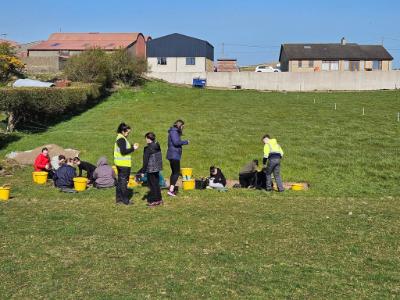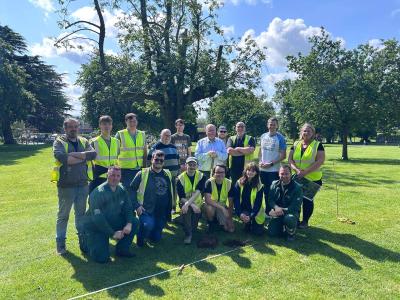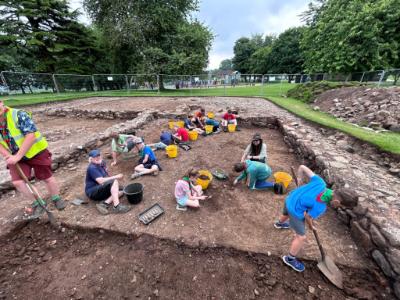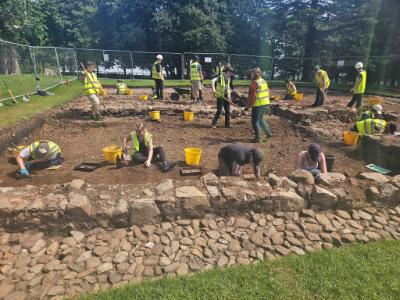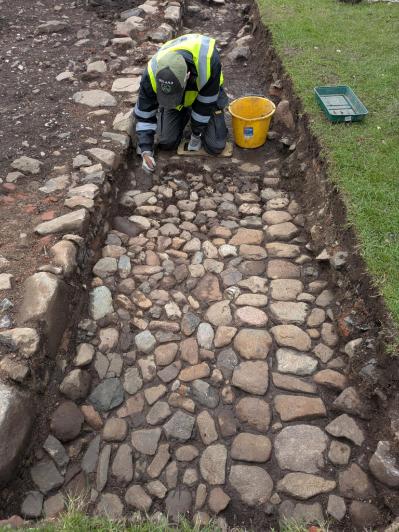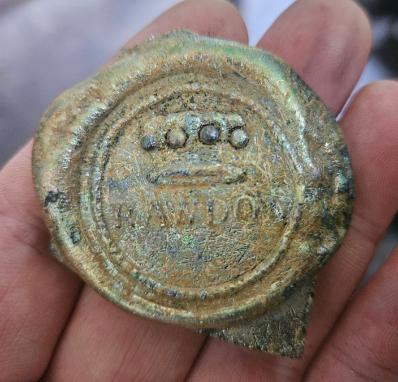CAPNI Excavations
Erenagh - April 2025
The excavation at Erenagh sought to uncover evidence for the now-lost medieval monastery. The Cistercian abbey was founded in 1127 by Niall Mac Dunlevi, king of Ulster; however, it was destroyed 1177 by John de Courcy (who later rebuilt Inch Abbey to make amends). Historical evidence suggests a church remained on the site for centuries, but today there are no standing remains visible. A geophysics survey showed evidence below the surface of what could be an extensive building complex. The excavations revealed a number of walls and metalled surfaces, suggesting buildings and occupation. A medieval date for the buildings is supported by the find of a Long Cross Penny of Edward I.
Moira Demesne - June 2025
Today Moira Demesne is a public park, opposite the church. But in the mid-1600s, Major Edward Burgh constructed a 'fine brick house' on the site; this was later acquired by Sir George Rawdon and remained in his family for generations. The excavations sought to expand on work carried out by the CCA in 2018 and 2019, which uncovered remains of a building, a stable yard and Bronze Age features. The 2025 excavations uncovered a cobbled surface and a large building, possibly a glasshouse or other outbuilding. One of the many finds included a fragment of a wine bottle embossed with the crest of the Rawdon family.
Derrygonnelly excavation 2025
A two-week excavation took place in Derrygonnelly, Co. Fermanagh, between 6th and 17th October 2025, directed by Professor Eileen Murphy. We embarked on the excavation hoping to find evidence associated with Sir John Dunbar’s early 17th-century Plantation castle which we know was cleared from the landscape in the early 19th century and has no upstanding remains visible today. Lots of 17th-century material remains, were found including imported pottery from England, fragments of clay pipe, building materials and a possible William and Mary ½ penny. We also found a 17th-century ditch that was potentially a temporary defensive feature when the castle was being built.
Hugely exciting and unexpected, were finds of flint and chert tools of Early Mesolithic date from around 9000 years ago. The nature of the these tells us that these hunter-gatherer people were actually living at this location and probably had a seasonal camp there. To add to the excitement, we also found evidence of a prehistoric round house which has been tentatively dated to the Early Bronze Age period, around 4000 years ago, because of a large fragment of pottery at the base of one of the post-holes of the house but the date will be confirmed via radiocarbon dates.
The community excavation at Derrygonnelly Castle created a huge buzz in the village. Since the castle was erased from the landscape in the early 19th century, people are largely unaware of its existence. The excavation raised awareness of this important site and also made many new prehistoric discoveries that will ensure Derrygonnelly is mentioned in future archaeological textbooks. Five local schools were involved in the excavation in addition to local home school families, a local girl guides group and a girls’ Lego construction team. We had 249 school children and 35 adult volunteers come and work with us on the excavation, along with many visitors. Many of the adult volunteers came along on repeated days with some there for the entire excavation. We were also delighted to welcome the Chair of Fermanagh and Omagh District Council, Councillor Barry McElduff, as well as Kellie Beacom and Melissa Birney from FODC, in addition to Pat Cullen, Sinn Féin MP for Fermanagh and South Tyrone.
Thanks are due to the funder, The National Lottery Heritage Fund; Peter Murphy, the landowner; Fermanagh and Omagh District Council; Derrygonnelly & District Community Partnership and the people of Derrygonnelly village for their total buy-in to the project.


